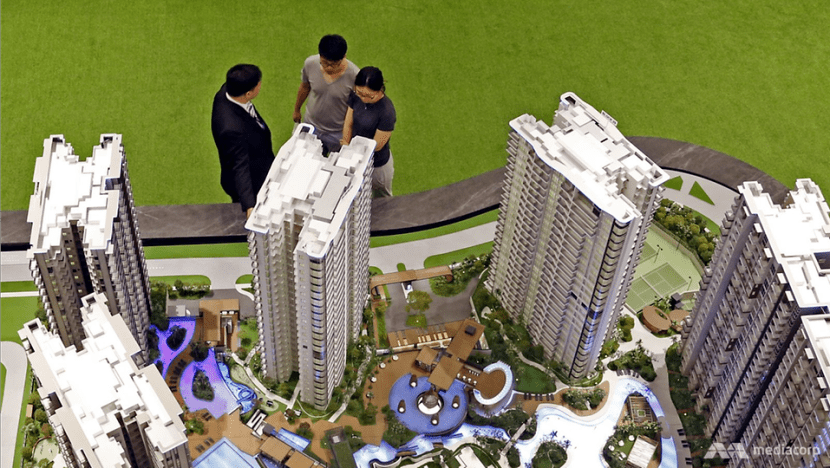Going big on space: Buyers eye larger homes amid pandemic

Prospective buyers at a condominium showroom. (File Photo: TODAY)
SINGAPORE: When the pandemic made working from home the default, clashing Zoom meetings became a regular occurrence for Mr David Tan and his wife, who live in a 914sqft four-room Housing & Development Board (HDB) flat.
They had to settle in separate nooks of the flat, which was often less than ideal, as they were not configured for work.
But soon, the couple will be moving to a bigger nest – a 1,130sqft condominium unit in the same area.
“Now we can probably have a proper study, and we can set up another work desk within the bedroom to have a proper set-up for Zoom meetings,” said Mr Tan, an analyst in his early 40s.
“Work-from-home (WFH) is the norm and more employers are becoming more flexible with their WFH arrangements. Given that we will be spending more time at home, I thought it’s natural to make it more comfortable.
“You’ll (also) be spending more time with family, so I thought: ‘Why not look for bigger place?’”
READ: Commentary: Why employers should cover WFH expenses
Mr Tan forms a growing group of buyers who have purchased bigger spaces, driven by the pandemic and its impact on lifestyle needs.
It’s a trend that can be seen across different segments of homes, said experts.
OrangeTee’s senior associate district director Ryan Tan said about eight in 10 clients he meets are now looking for bigger flats, compared to six in 10 before the pandemic.
He noted that beyond HDB dwellers who are looking to upgrade, he also has clients who have sold off their condominiums to buy larger public flats.
BUYERS SNAPPING UP LARGER HDB FLATS
Data from analysts shows that larger HDB resale flats have become more popular of late.
This is based on comparisons between pre-pandemic data from 2019, and from Q3 2020 to Q1 2021 – after the 'circuit breaker' period in Singapore.
One- to three-room flats are considered smaller units, while four-room units and above are considered larger ones.
Across these periods, average quarterly sales went up some 18 per cent for smaller HDB resale flats, but rose about 34 per cent for larger ones, according to Nicholas Mak, Head of Research & Consultancy at ERA Realty.
He added that the biggest increase in sales was for five-room and executive flats. Average quarterly sales for these jumped by about 40 per cent.
As for the BTO market, Christine Sun, senior vice-president of research and analytics at OrangeTee & Tie, said that sales are still dependent on the supply of homes released.
“Currently, the bulk of supply remains to be four-room flats and there is no noticeable major increase in larger flats like five-room room and executive flats released in recent launches,” she said.
GROWING APPETITE FOR LARGER PRIVATE HOMES
The trend has also left a mark on the new private apartment segment.
The median size of purchased units grew from 710sqft to 743sqft, an increase of about 4.5% year-on-year, said Mr Wong Xian Yang, Cushman & Wakefield Singapore’s head of research.
“While this is not a major factor now, buyers, especially owner-occupiers are seeing a stronger need and are willing to spend a bit more for having an allocated work space, like a study room, at home as they anticipate higher levels of remote work,” Mr Wong said.
READ: Commentary: The new frontier of hybrid work is taking shape
Specifically, this is the case in the city fringe and suburban regions, where buyers tend to be first-time owners or upgraders who wish to live in the unit, he said.
But units in the core central region have bucked the trend, continuing to decline.
This could be because a larger proportion of buyers of units in the city centre are investors, while affordability is also more of a constraint there, Mr Wong said.
READ: IN FOCUS: How a year of COVID-19 changed Singapore forever
Even in more recent times – from Q1 2021 to the quarter before, there has a clear increase in demand for homes above 1,200 sqft, said OrangeTee & Tie’s Ms Sun.
She noted a 72 per cent increase in new home sales above 1,200 sqft, from 362 units in Q4 2020, to 623 units in Q1 2021. This includes landed property, non-landed and executive condominiums.
Another reason for the demand for larger units: “The price resilience of properties in Singapore may have also driven some to purchase bigger units now for fear that the price increase may put such units out of reach in future,” said Ms Sun.
Mr Tan, the buyer, echoed this: “Given also that we are seeing economic recovery, where usually things go up, prices go up - why not maybe just upgrade and buy a bigger place (now)?”
TREND NOT SEEN IN PRIVATE RESALE MARKET
However, a growing interest in larger homes has not been observed in the private non-landed resale market, said Cushman & Wakefield’s Mr Wong.
“Given their already larger unit sizes which allows easy accommodation of a study area, the Singapore resale market activity remains characterised by affordability constraints which have driven demand for shrinking unit sizes,” he said.
Ms Sun also said her data does not point towards this trend.
ERA’s Mr Mak ventured this could be because the potential of an en bloc cycle is leading owners to hold on to their properties, which tend to be older and larger.
This could also lead to fewer such resale transactions this year, he said.
READ: Possible revival of en bloc market in 2021 as developers look to replenish land banks: Analysts
LANDED HOMES
Finally, Mr Mak also said that hunger for landed housing has grown, evidenced by the 6.7 per cent jump in prices for the segment seen in the first quarter of 2021.
Before the pandemic, an average of 385 new and resale landed homes were sold every quarter in 2019, he noted.
But since the circuit breaker lifted, this figure has ranged from 650 to 869 each quarter.
READ: Private home prices beat flash estimates to rise 3.3% in Q1, boosted by landed properties
“Since the start of the pandemic and WFH culture, many people would prefer more spacious homes but not everyone can afford to buy larger real estate.
“Those who have the financial capabilities to do so had fuelled the increase in the transactions of landed housing. Furthermore, the rising prices of condominiums had also made landed housing appeared to be value for money, resulting in higher demand for the latter,” he said.
Moving forward, the trend may signal a larger need for developers to consider new ideas for their future developments.
They might want to reconfigure their unit mix to include more large units, or have fitting or facilities that support the culture of WFH, said Ms Sun.












